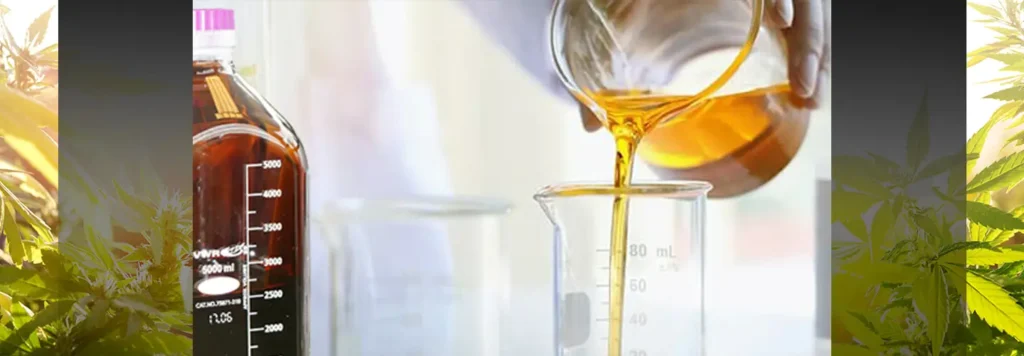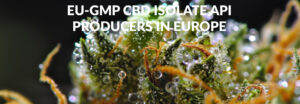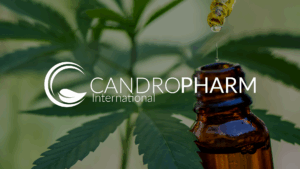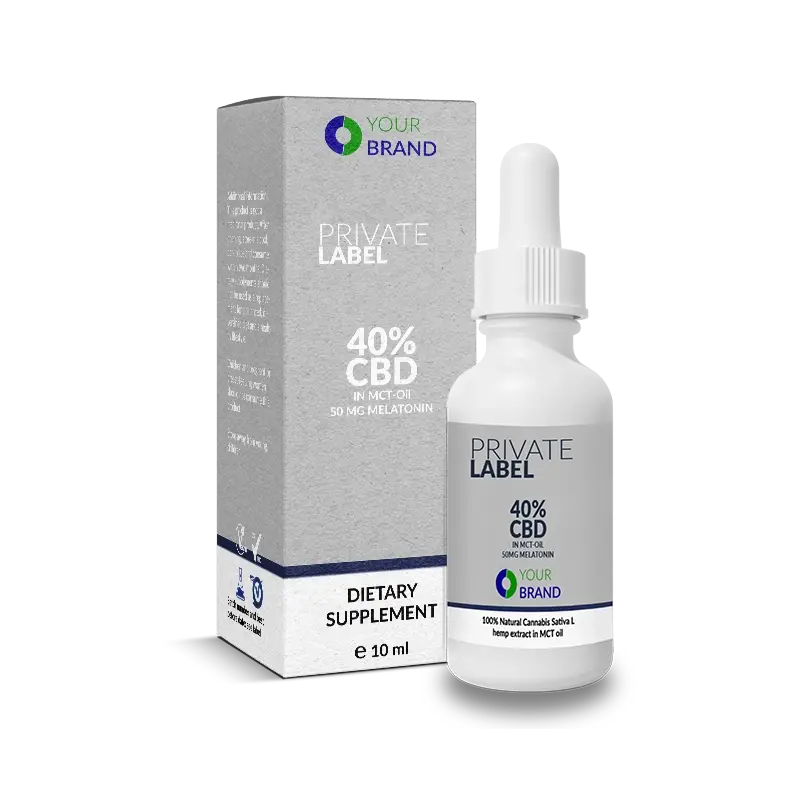How to Avoid Crystallisation of a highly dosed CBD Oil
How to prevent Crystallisation of a highly dosed CBD Oil. CBD oil with high concentrations of cannabidiol can sometimes crystallise, causing concern for users and producers alike. This process occurs when the CBD molecules clump together, forming solid crystals in the oil. While crystallisation doesn’t affect the oil’s potency, it can make it difficult to use and measure doses accurately.
After producing a high 40% CBD oil it starts to crystallise: Causes and Solutions for CBD Crystallisation
CBD oil with high concentrations of cannabidiol can sometimes crystallise, causing concern for users and producers alike. This process occurs when the CBD molecules clump together, forming solid crystals in the oil. While crystallisation doesn’t affect the oil’s potency, it can make it difficult to use and measure doses accurately.
To prevent CBD oil from crystallising, producers can add carrier oils or use different extraction methods to keep the CBD molecules suspended in the liquid. These techniques help maintain the oil’s consistency and ensure it remains usable. Some users also find that gently warming the oil can temporarily reverse crystallisation, though this should be done with care to avoid damaging the product.
Understanding why CBD oil crystallises and how to address it is crucial for both producers and consumers. By learning about this process, users can make informed decisions about their CBD products and ensure they’re getting the most benefit from their purchases.
Key Takeaways
- High-concentration CBD oil can crystallise due to molecular clumping
- Adding carrier oils or altering extraction methods can prevent crystallisation
- Gentle warming can temporarily reverse crystallisation in some cases
Understanding CBD distillate and Its Forms
CBD comes in various forms and concentrations. The type of CBD product and its spectrum affect how it works in the body.
Cannabidiol and Its Derivatives
CBD is a cannabinoid found in Cannabis sativa. It’s extracted from hemp plants and can be made into oils, edibles, and topicals. CBD oil is popular due to its versatility and ease of use.
CBD isolate is pure cannabidiol with no other compounds. It’s a crystalline powder that can be added to other products.
Full-spectrum CBD contains all hemp plant compounds, including trace amounts of THC. This creates an “entourage effect” that may boost CBD’s benefits.
Broad-spectrum CBD is similar to full-spectrum but has THC removed. It keeps other cannabinoids and terpenes.
Different Spectrums of CBD Products
Full-spectrum CBD products contain up to 0.3% THC. They may be more effective due to the entourage effect, but can show up on drug tests.
Broad-spectrum CBD offers a middle ground. It provides some entourage benefits without THC.
CBD isolate is 99% pure CBD. It’s tasteless and odourless, making it ideal for adding to food or drinks.
Terpenes are aromatic compounds found in hemp. They contribute to the smell and taste of CBD products and may have their own health benefits.
The Science Behind CBD Crystallisation using CBD Isolate
CBD crystallisation occurs due to specific chemical properties and environmental factors. This process affects the stability and usability of high-concentration CBD oils.
Factors Affecting CBD Crystallisation
CBD starts to crystallise in oils when its concentration reaches about 60-70%. This happens because CBD molecules begin to stick together and form solid structures. Temperature plays a crucial role in this process. Cold temperatures speed up crystallisation, while warmer conditions slow it down.
The purity of the CBD also matters. Higher-purity CBD is more likely to crystallise than CBD mixed with other compounds. Other cannabinoids and plant materials can interfere with crystal formation.
Time is another important factor. Even at room temperature, high-concentration CBD oils may crystallise if left undisturbed for long periods.
Comparison with Other Cannabinoids
CBD behaves differently from THC when it comes to crystallisation. THC is less prone to forming crystals in oil solutions. This is due to differences in their molecular structures.
CBD has a more rigid structure, making it easier for the molecules to align and form crystals. THC, on the other hand, has a more flexible structure that resists crystallisation.
Other minor cannabinoids, like CBG and CBN, also have different crystallisation tendencies. These differences can affect the stability of full-spectrum CBD oils compared to CBD isolate products.
Understanding these variations is crucial for developing stable, high-potency CBD formulations. It helps manufacturers choose the right mix of cannabinoids and carrier oils to prevent unwanted crystallisation.
Extraction and Production Techniques
CBD extraction and production involve complex processes to obtain high-quality oils. These methods aim to maximise CBD yield whilst maintaining purity and potency.
Advanced CBD Extraction Methods
Carbon dioxide extraction is a popular technique for CBD manufacturers. It uses pressurised CO2 to pull CBD from cannabis plants. This method produces clean, high-quality extracts without residual solvents.
Steam distillation is another method used to extract CBD. It involves passing steam through cannabis plant material to separate the oil. Whilst less efficient, it’s a gentle process that preserves terpenes.
Solvent extraction uses substances like ethanol or olive oil to strip CBD from plants. It’s cost-effective but may leave traces of solvent in the final product.
From Plant to Oil: The Production Process
The journey from plant to CBD oil begins with careful harvesting and drying of cannabis plants. Producers then grind the plant material to increase surface area for extraction.
Next, the chosen extraction method is applied. After extraction, the resulting mixture undergoes winterisation. This process removes unwanted fats and lipids.
The final step is distillation. It refines the extract, increasing CBD concentration. Some manufacturers use advanced techniques like chromatography for further purification.
Quality control is crucial throughout. Reputable CBD manufacturers test their products at multiple stages to ensure purity and potency.
Preventing CBD Crystallisation
CBD crystallisation can be a challenge for high-concentration oils. There are several effective methods to prevent this issue and maintain product stability. These techniques focus on altering the oil’s composition and storage conditions.
Strategies for Stability
Temperature control is crucial for preventing CBD crystallisation. Storing CBD oil at room temperature or slightly above can help keep it in liquid form. Some producers use gentle heating methods to re-dissolve crystals if they form.
Dilution is another key strategy. Adding carrier oils to high-concentration CBD can lower the overall CBD percentage, reducing the likelihood of crystallisation. MCT oil is a popular choice due to its stability and ability to blend well with CBD.
Winterisation is a process that removes waxes and lipids from the oil. This can help prevent crystallisation by eliminating compounds that might trigger crystal formation.
Carrier Oils and Formulations
Selecting the right carrier oil is vital for CBD product stability. MCT oil, derived from coconut, is widely used due to its resistance to oxidation and long shelf life. Other options include hemp seed oil, olive oil, and grapeseed oil.
Formulation techniques can also help prevent crystallisation. Some producers use a blend of different carrier oils to achieve optimal stability. Adding small amounts of alcohol or other solvents can help keep CBD in solution, though this may affect the product’s taste and legal status.
Emulsification techniques can create water-compatible CBD formulations. These can be more stable and less prone to crystallisation than pure oil-based products. Nano-emulsions, in particular, can improve stability and bioavailability.
Frequently Asked Questions
CBD oil crystallisation or granulation is a common issue with high-concentration products. Several factors contribute to this process, and various methods can prevent or remedy it.
What causes the crystallisation in high-concentration CBD oil?
CBD starts to granulate when CBD molecules form solid structures. This happens more easily in high-potency CBD oils, typically those with concentrations above 40%. As the solution becomes saturated, excess CBD molecules bond together, creating crystals.
Can certain solvents like pentane influence CBD oil’s tendency to crystallise?
The choice of solvent can affect crystallisation. Pentane and similar solvents may impact the oil’s stability. Some solvents evaporate more quickly, potentially leaving behind a more concentrated solution prone to crystallisation.
What methods are available to remedy crystallised CBD?
Gently warming the oil can dissolve crystals. A warm water bath or carefully applying low heat can help. Stirring or shaking the oil may also break up crystals and redistribute them throughout the solution.
Are there any effective strategies to prevent the solidification of CBD oil?
Keeping CBD oil at a stable temperature can help prevent solidification. Adding carrier oils like MCT oil can also reduce the likelihood of crystallisation by diluting the CBD concentration.
What factors contribute to the crystallisation process in CBD oil?
Temperature fluctuations, high CBD concentrations, and the purity of the CBD isolate all play a role. The extraction method and the presence of other cannabinoids can also influence crystallisation.
Is there a correlation between CBD oil consistency and temperature fluctuations?
Temperature changes can significantly affect CBD oil consistency. Cold temperatures may cause the oil to thicken or crystallise, while warmer tempe
Candropharm solution to avoid Crystalisation of CBD oils
Candropharm’s Innovative Solution to CBD Oil Crystallization
Crystallization is a common issue in the CBD industry, often resulting in a less appealing product appearance and potentially affecting bioavailability. Candropharm, a leading cannabinoid research and development company, has made significant strides in addressing this challenge with their groundbreaking technology.
Candropharm’s process focuses on preventing CBD oils from crystallizing, ensuring a stable and consistent product. Our innovative approach involves a carefully controlled extraction and refinement method that maintains the natural balance of cannabinoids and terpenes. This unique process helps to keep CBD molecules suspended in the carrier oil, reducing the likelihood of crystallization.
Our technology also incorporates specific carrier oils and natural stabilizers that work synergistically with CBD to maintain a homogeneous mixture. This not only improves the product’s shelf life but also enhances its overall quality and effectiveness.
By preventing crystallization, Candropharm’s CBD oils offer several advantages:
- Improved aesthetics: The oil remains clear and smooth, enhancing consumer appeal.
- Consistent dosing: Without crystals, each dose contains a uniform amount of CBD.
- Enhanced bioavailability: The absence of crystals may lead to better absorption in the body.
- Extended shelf life: The stable formulation ensures the product remains effective for longer periods.
Candropharm’s innovative approach to preventing CBD oil crystallization represents a significant advancement in the industry. As the demand for high-quality CBD products continues to grow, this technology positions the company at the forefront of cannabinoid research and development.









